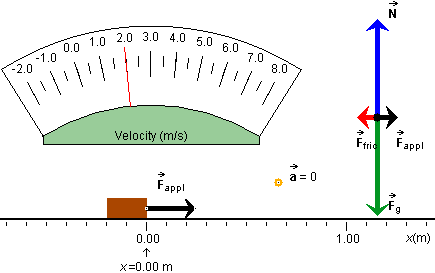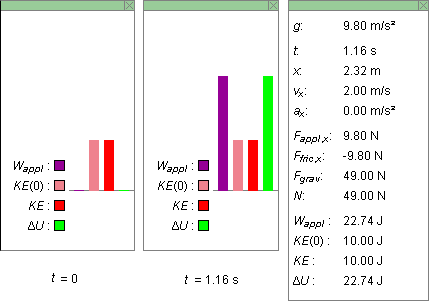Thermal Energy or Internal Energy
The terms thermal energy and internal energy are
taken to mean the same thing here. "Internal energy" is the
standard technical term while "thermal energy" is perhaps a bit
more colloquial.
Suppose a block is sliding on a horizontal table with friction. An
applied horizontal force  appl is acting on the block. The applied
force is equal in magnitude and opposite in direction to the
friction force so that the net force acting on the block is zero
and the block is moving with constant velocity. Figure 1 below
illustrates these conditions with an image taken with the applet on
Page 2 at time
t = 0.
appl is acting on the block. The applied
force is equal in magnitude and opposite in direction to the
friction force so that the net force acting on the block is zero
and the block is moving with constant velocity. Figure 1 below
illustrates these conditions with an image taken with the applet on
Page 2 at time
t = 0.

Figure 1
The table surface is represented as an x-axis pointing to
the right. The "velocitometer" shows the x-component of the
block's velocity to be 2.0 m/s.
Suppose we freeze the motion at t = 1.16 s. Figure 2 below
shows data from the applet's data box pertaining to this instant
and energy bars corresponding to the instants t = 0 and
t = 1.16 s.

Figure 2
The work Wappl done on the block by the applied
force during the 1.16-s time interval is equal to 22.74 J and
represented by the purple bar in the box for t = 1.16 s.
The kinetic energy has not changed during this time interval
because the block's speed is constant. Where did the energy go
that has been supplied in the form of applied work?
All of this energy was converted into internal energy of the
block-table system. Both the block and the table are getting a bit
warmer in the process. The internal energy of the block-table
system is denoted by the symbol U. The data box shows that
the change DU in this internal
energy during the 1.16-s time interval is 22.74 J, exactly the same
as the amount of applied work done. The green bar representing
DU in the energy box for t
= 1.16 s has exactly the same height as the purple bar representing
the applied work done.
Go to Page 2 to repeat this experiment with the applet yourself.
Take the block's mass to be 5.0 kg, set the kinetic coefficient of
friction to 0.20, set the magnitude of the applied force to 9.8 N,
and set the velocity to 2.0 m/s. This reproduces the conditions on
which Figures 1 and 2 are based.
For detailed information on how to use the applet, please see Help,
Assumptions, and ShowMe under Applet Help on the applet's Help
menu.
For more suggestions on what to investigate with the applet, see
Activities under Related Items.
 appl is acting on the block. The applied
force is equal in magnitude and opposite in direction to the
friction force so that the net force acting on the block is zero
and the block is moving with constant velocity. Figure 1 below
illustrates these conditions with an image taken with the applet on
Page 2 at time
t = 0.
appl is acting on the block. The applied
force is equal in magnitude and opposite in direction to the
friction force so that the net force acting on the block is zero
and the block is moving with constant velocity. Figure 1 below
illustrates these conditions with an image taken with the applet on
Page 2 at time
t = 0.

